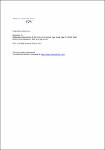Molecular interactions of porcine circoviruses type 1 and type 2 with its host
Mankertz, Annette
This review discusses the molecular interaction of proteins encoded by porcine circoviruses type 1 (PCV1) and type 2 (PCV2) with respect to the putative role for disease induction. Besides protein:protein interactions also proteins binding to PCV DNA are covered. Moreover, new approaches are considered which have been generated by genomic and proteomic techniques. PCV are still an enigma, when communication with the host and induction of disease are concerned. This is remarkably, since comparison of two viruses with a size of less than 2000 nts should easily identify the molecular trigger responsible for pathogenicity of PCV2. Since scientific life isn’t all beer and skittles we have to accept that this conundrum may be solved only in a long time range. The good news is that some common themes become visible and that certain aspects of the cell life cycle have been identified to be involved in interaction with the pathogen.
Dateien zu dieser Publikation
Keine Lizenzangabe

